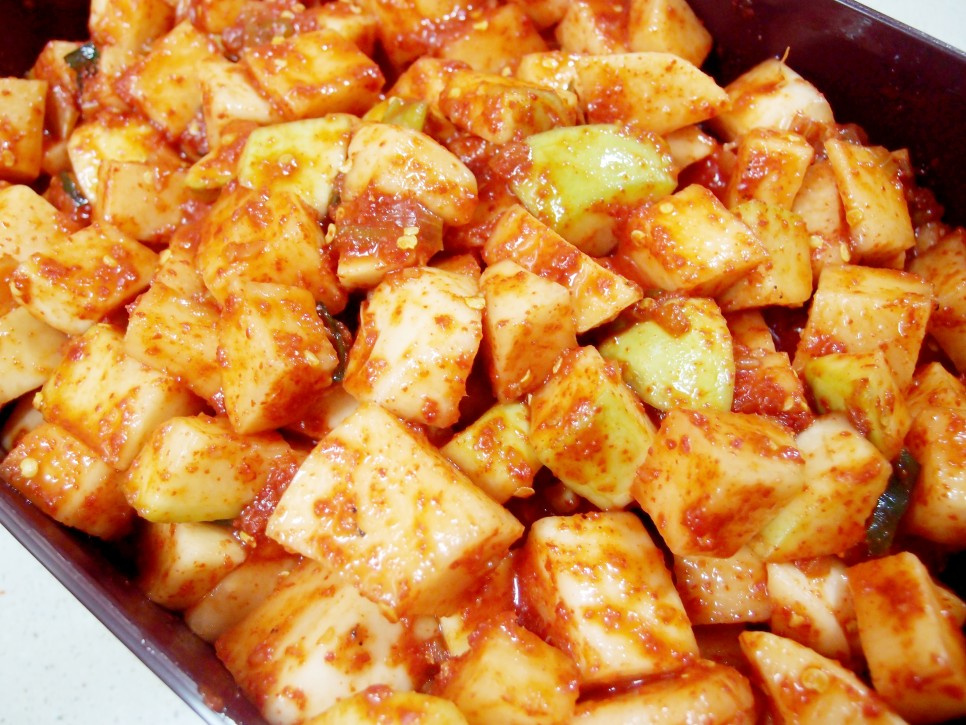Kkakdugi: Refreshing Korean Radish Kimchi with a Tangy, Sweet Broth
#Kkakdugi #KoreanRadishKimchi #SummerKimchi #EasyKimchiRecipe #HomemadeKimchi #SpicyAndTangy #FermentedRadish

For a refreshing summer side dish, Kkakdugi (cubed radish kimchi) is perfect with its crisp texture and a slightly sweet, tangy broth that stimulates the appetite. By preparing the kimchi paste the day before and letting it ferment, you can achieve a deeper, more complex flavor. This Kkakdugi is excellent served with bibimbap or in a hearty bowl of gukbap (rice soup). Enjoy a bountiful meal by pairing it with fresh yeolmu kimchi (young radish kimchi), which is in season. This recipe guides you through making delicious Kkakdugi with fresh radishes, suitable even for beginners.
Kimchi Paste Ingredients- 2 cups cooked rice flour paste (cooked rice flour mixed with water and cooled)
- 5 cups Gochugaru (Korean red chili flakes)
- 1 cup fine Gochugaru (or chili seeds)
- 2 cups Anchovy fish sauce
- 4 Tbsp salted fermented shrimp (finely minced)
- 3 Tbsp plum extract
- 2 Tbsp sugar
- 4 Tbsp minced garlic
- 1 Tbsp minced ginger
- 5 Tbsp chopped green onions
- 2 cups natural seasoning broth (dried pollack or anchovy-kelp broth)
Kkakdugi Ingredients- 3 medium-sized radishes
- 3 Tbsp coarse sea salt (for salting radish)
- 1 Tbsp sugar (for salting radish)
- 3 cups prepared kimchi paste
- 3 medium-sized radishes
- 3 Tbsp coarse sea salt (for salting radish)
- 1 Tbsp sugar (for salting radish)
- 3 cups prepared kimchi paste
Cooking Instructions
Step 1
First, prepare the cooked rice flour paste. Mix glutinous rice flour with water in a pot and cook over low heat, stirring constantly until thickened. Allow it to cool completely before use. The rice paste helps the seasoning adhere well to the radish.

Step 2
In a large bowl, combine the cooled rice paste with the Gochugaru (Korean red chili flakes) and fine Gochugaru (or chili seeds). Mix well to prevent lumps. Using fine Gochugaru will result in a smoother texture and richer color.

Step 3
Add the minced ginger to the mixture and stir it in thoroughly with the other seasonings. Ginger helps to eliminate any unwanted odors from the radish and adds a pleasant aroma.

Step 4
Next, add the finely minced salted fermented shrimp, anchovy fish sauce, sweet plum extract, and sugar. Stir until all the ingredients are evenly combined. Fish sauce and fermented shrimp are key ingredients that provide a rich umami flavor.

Step 5
Finally, pour in the cool broth (dried pollack or anchovy-kelp broth) and mix everything until the paste is well blended. It’s best to let this kimchi paste ferment in the refrigerator for at least half a day to develop a deeper flavor. Allowing sufficient fermentation time is crucial for great taste.

Step 6
Now, it’s time to salt the radish. Dissolve the coarse sea salt in water until it’s fully incorporated. Making a saltwater brine helps the radish to salt evenly.

Step 7
Peel and trim the radishes, then cut them into bite-sized cubes (about 2-3 cm). Pour the prepared saltwater over the cubed radish, then sprinkle additional coarse sea salt on top. Gently mix the radish with your hands to ensure it’s coated evenly. Let it salt for about 20-30 minutes.

Step 8
Rinse the salted radish under cold running water a couple of times to remove excess salt. Taste a piece of radish; if it’s too salty, rinse it again. If it’s not salty enough, you can add a bit more seasoning paste later. After rinsing, add 1 Tbsp of sugar to the radish and mix lightly. This helps to enhance the radish’s natural sweetness and allows the seasoning to penetrate better.

Step 9
Add the fermented kimchi paste to the drained radish. Gently mix everything together, ensuring the paste evenly coats all the radish cubes.

Step 10
Transfer the seasoned Kkakdugi into a kimchi container. Press down firmly with a spatula or your hands to remove any air pockets. This helps the flavors to meld and penetrate the radish. Let it ferment at room temperature for 2-3 days, then store it in the kimchi refrigerator to serve chilled. This aging process is key to achieving the perfect Kkakdugi flavor.

Step 11
Your delicious, well-fermented Kkakdugi is ready! Its crisp texture and refreshing broth are wonderful as a side dish, or delicious when mixed into rice or served with gukbap. Enjoy making and savoring this seasonal delight!



